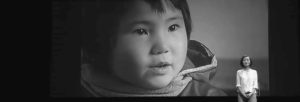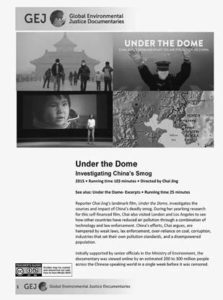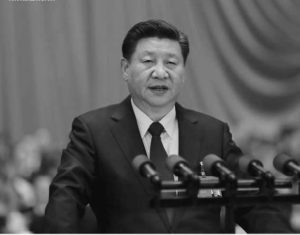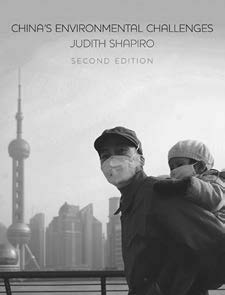Under the Dome was first shown in China on February 28, 2015 The documentary is now included in the Global Environmental Justice Documentaries Project, which is based in the USA and Canada and supported by the International Documentary Association. The title of the documentary was taken from the book Under the Dome, written by Stephen King and published in 2009. (The documentary is about China; the book is about the USA.) The documentary is also available online.

Source: Screen capture from Under the Dome on the GEJ website at https://tinyurl.com/khwnpfxc.
Synopsis
This video is an investigative report on the subject of China’s environment and the problems of air pollution. The narrator is Chai Jing, a television reporter who uses professional skills to blend her story as a mother with topics such as health sciences, manufacturing, national economics, and the rise of China since 1980. To tell her story, Chai Jing narrates trips throughout China to places such as hospitals, worksites, powerplants, steel mills, gas stations, and government offices. Many doctors, citizens, workers, factory managers, and officials are interviewed on camera. Chai Jing’s trips also took her to foreign countries as she discussed the world environment. The story of being a mother is presented with beautiful narration and subdued emotion—environmental issues are discussed with scientific precision. Problems and solutions are covered, but viewers are left with a huge question: will China save its children?
Chai Jing started the video by discussing environmental issues in Beijing in 2013. But then it becomes very personal when she talks about how she gave birth to a daughter and the little girl had health problems related to air pollution. Being a television reporter, Chai Jing wanted to understand what happened to her child and what was happening in China. She learned about localized smog, i.e., polluted air, but also nationwide problems of cancer, polluted rivers, and issues with coal mining. She tells us about raising children and counting days when pollution is too high for going outdoors. In essence, the audience is seeing a mother’s complaint about modern China. But Chai Jing is a reporter, and she did research with information from sources such as America’s National Aeronautics and Space Administration (NASA), China’s prestigious Peking University, and the Chinese Academy of Science. The production values of the video are excellent, as Chai Jing’s talk is given in the style of a Technology Entertainment Design (TED) presentation with a single narrator on a stage with film clips and graphics inserted. A mother’s love is combined with scientific data to seek solutions.
Chai Jing started the video by discussing environmental issues in Beijing in 2013. But then it becomes very personal when she talks about how she gave birth to a daughter and the little girl had health problems related to air pollution.
Chai Jing learned that coal-burning powerplants are a major source of pollution in China—this is a well-documented fact and a global problem. To make her point about coal, Chai Jing took a trip to England to teach the lesson that while coal was a terrible problem in the past, England attacked the problem and there are solutions to pollution from coal. The trip to England illustrates that Chai Jing had considerable financial support for the video. Pictures of very bad pollution in London show viewers that coal can be washed, and the burning of coal in England has been greatly reduced. There is a fascinating dialogue with an English official who explains that the services of a Chinese company are to make London cleaner with electricity! The lesson is clear: if England can reduce pollution, why not China?
Pollution from automobiles and trucks is the next topic explored by Chai Jing. Here the audience is taken into the workings of the China Petroleum and Chemical Corporation (SINOPEC) and shown interviews with officials of the Chinese Environmental Protection Bureau (EPB). Chai Jing is making the point that industries and bureaucracies are huge, that China has an EPB, but the solution of slowing down the economy for environmental protection has not been enforced. Plant managers and environmental officials are put on the spot as they explain why they can’t stop economic progress. China has the research and environmental laws, but making money comes first!
To provide a solution, she takes the audience on a trip to America to tell the story of how Los Angeles greatly reduced its infamous smog caused by gasoline engines. Here again, we note the financial support for the documentary, as Chai Jing was able to use a helicopter trip over the city to show viewers the great number of cars. Chai Jing shows clear skies over California and explains how the pollution from gasoline engines was greatly reduced through emissions controls. The concept of “fake cars and trucks” used in China is explained (i.e., vehicles are produced with faked documentation to hide the fact that emissions controls were not put on the engines). Chai Jing shows to the audience the story of how the American automobile industry and Environmental Protection Agency (EPA) reduced pollution to improve public health. Japan was mentioned to include the technique of limiting the number of vehicles in the large area of Tokyo. The investigative reporter makes her case that there are solutions to environmental problems. It is interesting that Chai Jing did not emphasize electric vehicles as a solution, but she does note that natural gas should be used more in China. To counter objections about slowing down the economy, Chai Jing talks about recognizing that national security is linked to energy production and that the American automobile industry shows that free market solutions improve economies.

Source: Screen capture from Under the Dome on the GEJ website at https://tinyurl.com/khwnpfxc.
To conclude Under the Dome, Chai Jing reviews how the government must enforce good laws and citizens must be more active. She stresses that people should use public transportation, complain about pollution by calling phone number “12369,” and use all forms of social media. The message is clear: government and people must work for improved health. In this documentary, investigative reporting, scientific research, trips abroad, and interviews are used to teach about health issues. The signature note of the program is in the last few minutes, where Chai Jing returns to the theme of a mother’s love for her child as she shows graphics of the planet Earth and talks about how her child should live in a clean and beautiful world in the future—this documentary is science combined with art.

Teacher’s Guide
The website of Global Environmental Justice for Under the Dome also provides a very useful teacher’s guide, which can be used in many ways. The guide features an interview with Chai Jing, a minute-by-minute outline of the film, discussion questions, comments on the short excerpts, an activities list, and five additional resources. The interview tells us more about Chai Jing’s reasons for doing the project and how she was able to do it. The outline of the film gives teachers a way to study sections of the presentation and prepare their own comments for talking with students.
Adventurous students could do amazing things if directed to plunge into what is going on now with Chinese social media!
Eight discussion questions are suggested for us. Question 5 says, “What are the pros and cons of using personal vignettes in journalistic reporting? In environmental advocacy?” Answers to these questions should lead to opening the topic of how to present a documentary to connect with a desired audience. The widely viewed TED programs often use a personal story for empathy with viewers. Question 6 says, “What are some of the challenges in China? In your home country?” These questions present the opportunity to pause and reflect upon comparing China to our home countries. This would be a good place to have students gather comparative statistics to remind us that China is not the only place with environmental issues.
The twenty-five-minute excerpts, which feature pollution from cars and trucks, are discussed, and this topic provides a wonderful segue into research and discussion of the development of electric cars and trucks. Vehicles with electric motors do not pollute the air, but the electricity has to come from some source of energy. Teachers can review how China is aggressively pushing the use of electric motors in vehicles to reduce harmful emissions. But then, we return to the source of the electric power to fully investigate environmental problems. The activities related to Under the Dome emphasize students researching, viewing, and exploring resources and topics. Here, we are provided with the titles of many other films on China and some knowledge of the history of documentaries. I was surprised to find the suggestion that students might research how the Chinese stock market was impacted by the documentary.
The fifth activity is to “explore the role of censorship of the media in China over time. How has it evolved in response to social media?” These questions open a Pandora’s Box of endless and creative research. Just think about the long history in China concerning censorship of heterodox (un-conformist) ideas in favor of state-approved concepts. Freedom of the press is not strong in Chinese history. Adventurous students could do amazing things if directed to plunge into what is going on now with Chinese social media! Online sources for this topic are enormous—I found another surprise in the suggestion to explore the website of the US Embassy in Beijing because it shows air quality data.
The teacher’s guide ends with five additional resources to further extend and update our use of the documentary. Information is provided for Google Maps, a periodical article, and three books. Since Under the Dome came out in 2015, the additional materials bring us up to 2018 to help stay current in teaching. Events in China are racing ahead, and we must carry Chai Jing’s story forward.
Teaching Strategies
As I reviewed Under the Dome, I was thinking about how it could be used in teaching. Three strategies occurred to me. First, the persona of Chai Jing could be discussed as an “antistereotype.” By this I mean, I see China on television and social media as represented by images of grim-faced officials saying something negative or confrontational about the USA—these images are a negative stereotype. To the contrary, Chai Jing is talking positively about a better world for all of us. There is more to China than angry officials—we need to show our students that a country of 1.4 billion people has enlightened, educated, well-informed citizens who have traveled widely and understand global problems.
I am reminded of “people to people” programs, which existed in the past, where Americans were encouraged to interact with foreigners to work together in peace. Teachers could prompt students to watch and listen to Chai Jing as she narrates Under the Dome and to think about her as an example of a spokeswoman for environmentally aware people, and reflect upon the fact that hundreds of millions of Chinese viewed the documentary. Think of Under the Dome as international communication in a very personal way.
Teachers might also present a “mini-biography” of Chai Jing to explain that she is an award-winning reporter on China Central Television, CCTV, which is a government network that is accessible nationwide. CCTV is known for following the dictates of the Chinese Communist Party (CCP). Chai Jing’s reputation stretched beyond China to America in 2015 when she was named one of Time magazine’s 100 most influential persons.

Source: The Xinhuanet website at https://tinyurl.com/hns479ep. The full report can be accessed on the China
Daily website at https://tinyurl.com/5tzs8v4v.
The second strategy that might be used in teaching is to discuss why the documentary was banned by the CCP in 2015. To me, this is the “banned in Beijing” theme. To do this, teachers could review that in 2012 Xi Jinping became the new leader of China and then acquired all the very important leadership positions so that he may be in office for his lifetime. Xi Jinping’s titles include being chairman of the Chinese Communist Party and the President of China—his policies stress that the CCP leads in all aspects of life, including the private sector and the environment. The emphasis on CCP dominance cannot be exaggerated—perhaps he prefers to be known as Chairman Xi?
Xi has spoken at length about an environmental crisis, especially in a speech to the 19th Party Congress in 2017 that is known as the “mother of all reports.” In broad general terms, President and Chairman Xi’s environmental policies and goals for the future read very well and are similar to what many environmental activists call for. Xi clearly recognizes that the PRC has an environmental crisis, and he has solutions to the problems. Xi talked about harmony between humans and nature, reforming systems, and an ecological civilization with a beautiful environment. Green technology was emphasized by Xi in stressing that air and water pollution must be targeted. And Xi endorsed global environmental cooperation. As a result of “the mother of all reports,” environmentalism was placed in the CCP constitution.
It would be very interesting to hear a discussion between Chairman Xi and citizen Chai! Thus, Xi Jinping and Chai Jing both have environmental agendas, and in China, the CCP is to be the leader in everything. It would follow that Under the Dome was banned because it was not done by the CCP or the Chinese Environmental Protection Bureau. I wonder if the foreign portions in the documentary, i.e., the trips to England and America and comparisons to world standards, might not be objectionable to the CCP. It is as if the CCP says, “There is a problem, but we will take care of it.” The voice of the CCP is to be heard above all others . . .
It would be very interesting to hear a discussion between Chairman Xi and citizen Chai!
 A third strategy for teachers could be to combine several resources to teach about the large subject of China’s environment. Begin with watching Under the Dome as a wonderful example of public activism in China and, again, the concept of the persona of Chai Jing as a global citizen. Select elements from the teacher’s guide that fit in with your class presentations. Then, have students read a book, such as the latest edition of Judith Shapiro’s China’s Environmental Challenges. This book gives some background on Chinese history leading to current problems and explains a lot about the government of China, with acronyms of myriad organizations, including the Environmental Protection Bureau, and the laws of the country. Professor Shapiro makes a great point with her emphasis that China’s problems are world problems. Finally, return to the concept of Chairman Xi’s policies to learn what he intends to do with the environment. The problems are obvious, some solutions exist, and the question is “Will the solutions be applied to the economy?” With this strategy, the past, present, and future of the environment could be taught. Creative teachers have a lot of choices on this topic. Under the Dome is highly recommended for advanced high school classes and college courses dealing with film studies and environmental issues.
A third strategy for teachers could be to combine several resources to teach about the large subject of China’s environment. Begin with watching Under the Dome as a wonderful example of public activism in China and, again, the concept of the persona of Chai Jing as a global citizen. Select elements from the teacher’s guide that fit in with your class presentations. Then, have students read a book, such as the latest edition of Judith Shapiro’s China’s Environmental Challenges. This book gives some background on Chinese history leading to current problems and explains a lot about the government of China, with acronyms of myriad organizations, including the Environmental Protection Bureau, and the laws of the country. Professor Shapiro makes a great point with her emphasis that China’s problems are world problems. Finally, return to the concept of Chairman Xi’s policies to learn what he intends to do with the environment. The problems are obvious, some solutions exist, and the question is “Will the solutions be applied to the economy?” With this strategy, the past, present, and future of the environment could be taught. Creative teachers have a lot of choices on this topic. Under the Dome is highly recommended for advanced high school classes and college courses dealing with film studies and environmental issues.

